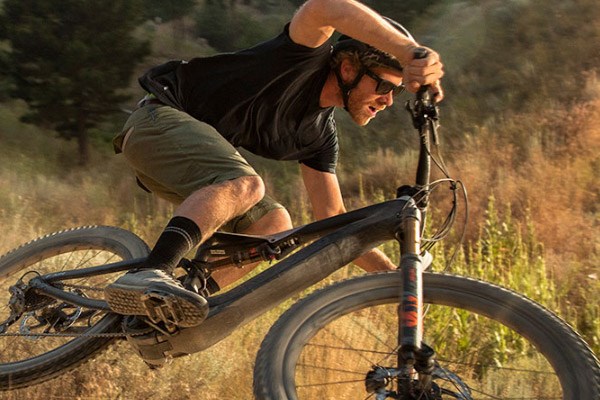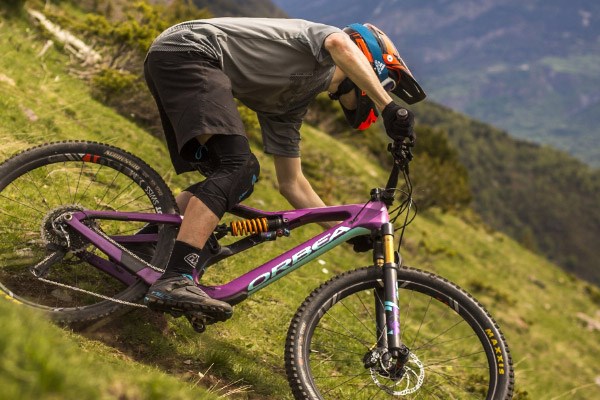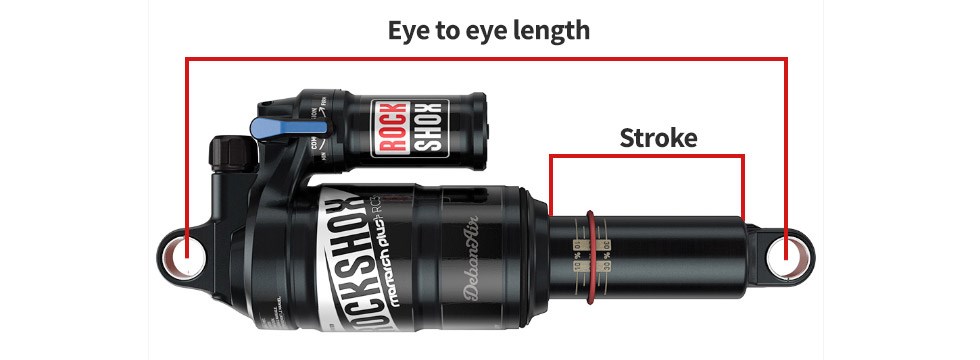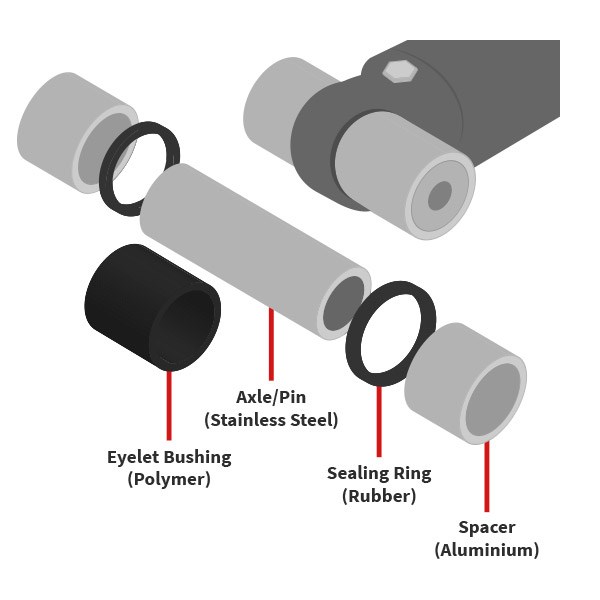For full suspension bikes, rear wheel travel is controlled by a shock. There are two fundamental types of shocks, Air shocks and Coil shocks. They are named by the type of spring used. The ride can be dramatically improved with an upgraded shock, increasing grip and confidence when riding. A replacement or upgraded shock fitment will be determined by the spring type (Air or Coil) and Size (Eye-to-eye and stroke length).
Rear wheel travel cannot be increased by installing a longer shock, the linkage of the frame governs rear wheel travel and is designed to work with a specifically sized shock.
As with most performance upgrades the more you spend on a rear shock the more benefits are available either in feel and support, adjustability, or both. Balancing the bikes suspension characteristics front and rear are vital to a good set-up, so if you upgrade your fork, the shock should be next on your list.
Air Shocks
Lighter and more adjustable than coil, Air shocks were traditionally used on XC, trail and enduro bikes but recently are stock on some downhill bikes. The air spring is simply and quickly adjusted using a shock pump to set sag and spring rate for any rider weight and riding style.
Air shocks in their nature are more progressive than coil, ramping up the spring rate as the shock compresses. This progression can be tuned and personalised using internal volume spacers..
This means air shocks are incredibly versatile, they can be tuned to different rider weights (With and without a full backpack for example) and work with almost all frame designs and types of bike.

Coil Shocks
Traditionally used on downhill and freeride bikes, but now seen on some Enduro bikes, coil shocks can feel very plush, offer greater small bump sensitivity over air shocks and often have simpler internals. Many riders do enjoy the extra ground hugging grip and feel of a coil shock.
They are however heavier than air shocks and are lacking in quick and easy adjustability. Coil shocks can be tuned to your riding style by using a spring with the correct spring rate for your weight. The best spring for you will most likely be purchased separately, some riders will find they experiment with different springs to find their best set up.

Springs are rated by pounds (lbs) and this should be printed on the spring along with the travel length of the spring in inches. For example 400 lbs x 2.25”. Coil springs are available in either steel or titanium, there is no noticeable performance difference between the two apart from the weight advantage of titanium.
Most people will experiment with spring rates to find the right spring for them, although a few turns of preload can be added when setting sag it is always best to find the correct spring rate for your weight, riding style, and frame.
Coil shocks are linear in their nature, so do not suit all linkage designs and therefore do not offer the best performance or work well on every full suspension frame.
Compatibility
It is not as simple as just bolting on any rear shock, there are some very important measurements to take into consideration. Once the spring type (air or coil) has been decided, there two fundamental measurements needed.

Eye to eye: The total shock length. Measurement is made between the centres of each mounting hole/bolt in a straight line. This must match the new shock and is listed by the frame manufacturer in either mm or inches, often along with the stroke length. eye to eye is listed first and stroke length second. For example, 190mm x 50mm or 7.5” x 2.0“
Stroke length: The amount of travel the shock has (not the bike) can be seen by how much the telescopic part of the shock moves under full compression. Either the shaft itself can be measured or it can be worked out from the difference between the eye-to-eye length when fully extended, and fully compressed. Shown as the second number in the shock size by the manufacturer (eg 190mm x 50mm or 7.5” x 2.0”), this again should be the same as the original shock and as intended by the frame manufacturer to work with that particular linkage design.
Mounting hardware
Hardware includes the bushings and bolts that fit into the eyelets at either end of the shock, allowing it to be fitted to the frame. Although standards are starting to settle, the hardware will vary with each frame and shock combination. If replacements are needed there are dedicated suspension tuning specialists who can supply these parts. Please call our Bike Specialists on 01792 346501 if you need any more advice.

Adjustments
Spring Rate - The spring rate of a shock governs how much force is needed to move the shock through its travel.
This is directly associated to rider weight, riding style and the bikes linkage design. An air shock’s spring rate is easily adjusted using a shock pump and requires no additional parts. A Coil shock’s spring rate is adjusted by fitting different strength springs.
Compression damping - controls how the shock moves through its travel, some basic shocks might not have any control over compression damping while some will have a “lockout” switch, this can also be called a “Climb switch”, or “Firm mode”.
Other more expensive shocks might have multiple options, for example, a “Climb, Trail, descend” switch or “open, medium, firm” while top-line shocks have precise control of both high and low-speed compression.
Rebound - Adjusts how fast the shock returns to full extension or sag point.
Rebound adjustment can be found on entry level shocks. Top-line shocks will have separate high and low-speed rebound adjustment controlling how the show reacts after high and low-speed compressions.
Setting Sag
Once a new shock is installed, before tweaking any adjustments the sag should be set for rider weight and riding style. This is done by adjusting the spring rate.
While standing on the bike in the attack position the suspension should usually be using around 25-35% of total travel under rider weight alone depending on the type of shock and amount of travel. We have a handy guide to setting sag here.
With an air shock, sag and spring rate are set using a shock pump, these are not included with a shock and must be purchased separately.
With a coil shock, the correct spring must be purchased for rider weight and riding style, with the correct spring fitted sag should be in the 25-35% range, the sag point can be fine-tuned by adjusting the pre-load on the spring. This is done through compressing the coil slightly by turning the adjuster ring clockwise. Compressing the spring slightly will increase the spring rate during the initial movement of the spring and therefore reduces the sag percentage. However only a few turns should be used, if any more is needed then it is best to change the spring to one that is correct for the rider weight.
Jargon Buster
Attack position – body position of the rider when riding into a technical section of trail, braced for any trail feature with weight balanced in the centre of the bike.
Compression – Controlling how the suspension moves through the available travel.
High-speed compression – How the suspension moves through the travel from High-speed hits not high-speed riding, for example rocks, roots, braking bumps, landing from jumps/drops etc.
Low-speed compression - How the suspension moves through the travel from low speed movement not low-speed riding, for example when under compression through a berm, going up a transition of a jump etc.
Linear – The strength required to compress the spring remains the same through the full movement.
Progressive – The strength required to compress the spring increases progressively through the full movement.
Metric – Referring to the eye-to-eye measurement of a shock in mm rather than inches.
Piggy-back – An extra part of the shock that comes out from the main body. This gives a larger oil volume for internal damping, offering better damping control and more consistent performance on extreme terrain. The frame design must have the space for this larger type of shock and will not fit all bikes.
Preload – How much the coil spring is compressed in its static state.
Rebound – how fast a shock returns to full extension.
Sag – how much travel is used under rider weight.
Shock pump – A high pressure air pump used to adjust air shocks, running at a much higher pressure than a normal inner tube/tyre pump.
Spring rate – The force needed to compress the shock.
Stroke length – the amount of travel the shock has, not the same as the amount of travel the bike has.
Trunnion – A trunnion mount shock has a larger body where one eyelet is housed in the body. This allows a longer stroke length in a shorter eye-to-eye.
Volume spacers – Internal plastic spacer that can be added inside an air shock to reduce internal air volume and so increasing the progression of the shock through its travel.



